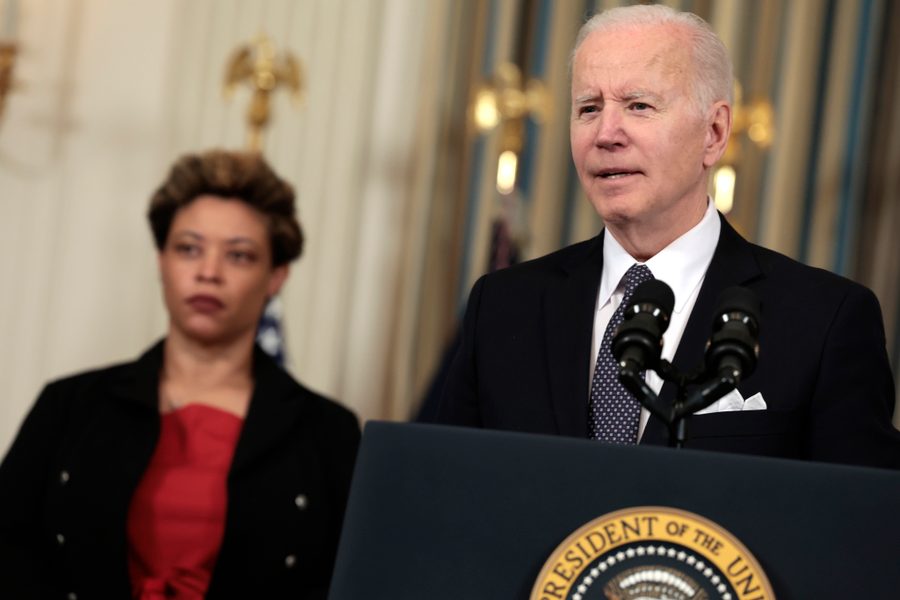Biden Is Using the Ukraine Crisis to Justify Dangerous Investments in Nuclear Weapons
The president’s budget calls for $50.9 billion in nuclear weapons spending.
Sarah Lazare

The Biden administration’s proposed budget for fiscal year 2023, released March 28, calls for massive investments in nuclear weapons, including the Ground Based Strategic Deterrent (GBSD) — an intercontinental ballistic missile system that is fiercely opposed by anti-nuclear activists.
President Biden is using Russia’s invasion of Ukraine to justify the investments, citing the alleged need for deterrence.
The budget proposes $34.4 billion to “recapitalize all three legs of the nuclear triad,” according to a Department of Defense summary. The “triad” is a reference to submarines, bombers and land-based intercontinental missiles, which comprise the U.S. military’s nuclear weapons program.
This proposal, focused on nuclear weapons delivery systems, includes $6.3 billion for the Columbia-class ballistic missile submarine (an increase of $1.3 billion, according to Bloomberg). Built by General Dynamics, the submarine is capable of carrying both nuclear and conventional missiles.
The budget also includes $5 billion for the B-21 long range strike bomber (an increase of about $2 billion, Bloomberg says), made by weapons manufacturer Northrop Grumman, which is also capable of deploying nuclear and conventional weapons.
It also calls for $3.6 billion for a GBSD. That system is a replacement for aging Minuteman III intercontinental ballistic missiles (ICBM) that are located in Colorado, Montana, Nebraska, North Dakota and Wyoming. It would also include further investments in launch facilities and control centers, test-launch missiles and other infrastructure. (The ICBM is considered the land component of the nuclear triad the Biden budget proposal referenced.) The GBSD would ensure that these missiles remain deployed in U.S. states for another 50 years.
Anti-nuclear activists have long argued that, instead of being reconstituted, the ICBM system — a core component of the Cold War nuclear apparatus — should be dismantled, a move that would help chip away at the global threat of nuclear escalation.
“Nuclear war would absolutely devastate human civilization, and ICBMs increase the chances of a catastrophic accident or miscalculation,” Alex Frandsen of the Friends Committee on National Legislation, a peace lobby organization, wrote in 2021 when opposing Biden’s funding of the program. “That’s because ICBMs are kept on high alert at all times, and hundreds of them would be launched with a single order. Once launched, they cannot be recalled. There is no room for error.”
“These missiles are some of the most dangerous weapons in the world,” former Secretary of Defense William Perry wrote in 2016. “They could even trigger an accidental nuclear war.”
In March 2021, Congressional Democrats proposed legislation to divert $1 billion in funding from this program into development for Covid-19 vaccines. (The bill has not passed.)
The GBSD was in motion well before President Biden’s 2023 budget proposal, and well before Russia invaded Ukraine. Putin’s invasion of Russia is being used to engineer justification for a policy that Biden likely would have already enacted.
Bloomberg calculates that the proposed spending on nuclear weapons delivery systems is towards the high end. “Total spending on nuclear weapons and systems research and procurement would grow to $34.4 billion from this year’s $27.7 billion request and the $33 billion projected for fiscal 2023 in the final Trump budget plan,” writes Anthony Capaccio.
Lindsay Koshgarian is the program director of the National Priorities Project, which researches military spending. She tells In These Times, “The fact that it is similar to the Trump projection makes me think that we are still in the world of prior nuclear modernization plans — which is still a world of spending $2 trillion on nuclear weapons over the next few decades.”
But this isn’t the only nuclear spending proposed. Beyond delivery systems, the budget also calls for $16.5 billion for nuclear weapons, under the Department of Energy.
This brings the total proposed nuclear weapons spending to $50.9 billion.
And this doesn’t even include other line items that would further resource nuclear weapons systems, like proposed funds for Space Force’s “nuclear command-and-control capability.”
The budget leans heavily into tensions with Russia as a justification for its line items.
“While focused on maintaining robust deterrence against China and Russia, the Budget would also enable DOD to counter other persistent threats including those posed by North Korea, Iran, and violent extremist organizations,” the proposal states.
“It preserves our readiness and deterrent posture against the threats we face today: the acute threat of an aggressive Russia and the constantly emerging threats posed by North Korea, Iran, and violent extremist organizations,” Secretary of Defense Lloyd J. Austin III said of the president’s proposed budget.
Koshgarian says the latest proposed nuclear investments reflect pre-existing Biden administration policy: “It’s not a surprise that they are fully committing to all three legs of the nuclear triad. The Russian invasion is giving them additional rationale for that.”
This is despite the fact, she says, that the invasion is showcasing the dangers of a nuclear arms race. (The United States and Russia account for 90% of the world’s nuclear weapons.) ICBMs are the reason why U.S. nuclear weapons can reach Russia, and vice versa, she notes.
The stakes are unfathomably high. One study from 2019 determined that “current nuclear arsenals used in a war between the United States and Russia could inject 150 teragrams of soot from fires ignited by nuclear explosions into the upper troposphere and lower stratosphere.” Under this scenario, smoke prevents 60% to 70% of sunlight from reaching the surface of the Earth for six months, temperatures plummet to freezing temperatures during the summer, and nuclear winter kills off much of human life.
The proposed investments in nuclear weapons come on top of high budget lines for military spending and law enforcement overall. The Biden administration is requesting $813.3 billion in “national security” spending, an increase of $31 billion, or 4%, compared to 2022, though that number doesn’t take inflation into account.
“The military budget was way too large to begin with,” says Koshgarian. “It’s not worth haggling over the exact inflation rate. The fact is that we’re living in a world where the Pentagon budget has been so high for so long, and we’re still maintaining that level.”
The budget also gives hefty funding increases to law enforcement: $15.3 billion for Customs and Border Protection, and $8.1 billion for Immigration and Customs Enforcement — increases of nearly 13% for both agencies. The budget for federal law enforcement would be increased by 11% to a total of $17.4 billion.
The budget also earmarks $4.2 billion for the “European Deterrence Initiative,” and $300 million in military assistance for Ukraine.
The budget is just a proposal and likely won’t pass in its full form, though military line items have historically received more bipartisan support. (And, in fact, some are already calling for higher military spending.) It was that military component that Biden emphasized in a statement on Monday, in which he said his budget is “one of the largest investments in our national security in history, with the funds needed to ensure that our military remains the best-prepared, best-trained, best-equipped military in the world.”
Sen. Bernie Sanders (I-Vt.) released a statement in response to the proposal, declaring, “At a time when we are already spending more on the military than the next 11 countries combined, no we do not need a massive increase in the defense budget.”
Sarah Lazare is the editor of Workday Magazine and a contributing editor for In These Times. She tweets at @sarahlazare.








